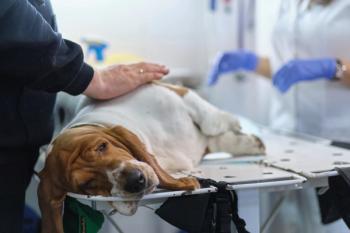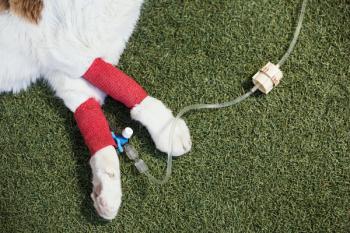
The new face of disaster response
SURPRISE, ARIZ. - Four years of patience and politics have paid off in what Dr. Lorna Lanman calls "vindication." The one-time Veterinary Medical Assistance Team (VMAT) member whose unit was expelled by the American Veterinary Medical Association in 2003, is now reinstated by the federal government.
SURPRISE, ARIZ. — Four years of patience and politics have paid off in what Dr. Lorna Lanman calls "vindication."
The one-time Veterinary Medical Assistance Team (VMAT) member whose unit was expelled by the American Veterinary Medical Association in 2003, is now reinstated as part of the federal government's latest reshuffle of the national veterinary network for disaster response.
A law now pushes AVMA out of its federal disaster response role, yet the association is exploring all possibilities to help, including coordinating an emergency-response militia at the local level.
Lanman heads the once-shunned VMAT group, now one of five units called National Veterinary Response Teams (NVRT).
"It feels good to be recognized," says Lanman, whose experience ranges from containing avian influenza to caring for 9/11 service dogs. "Getting our team back is a tribute to all our hard work and dedication."
At face value, the NVRT title change is a minor modification. Yet it's rooted in laws that have compelled the U.S. Department of Health and Human Services to cut ties with AVMA — the organization that founded VMATs and owns the name. The AVMA's four recognized VMAT units now operate as NVRTs, leaving the nation's largest veterinary membership organization to rethink uses for its trademarked identity.
The political turn of events opened the door for Lanman and her disbanded unit, once known as VMAT 4. As a result of a reported power struggle between AVMA and now-deceased team leader John Anderson, the unit was told to stand down or select a new head. The group, which at its height was composed of 60 members, refused the association's directive.
"John told us to keep our uniforms packed and ready to go. We knew that one day we'd be back in the system again," Lanman says.
Responding to needs: Veterinary Medical Assistance Team (VMAT) members examine patients in Punta Gorda, Fla., after Hurricane Charley in August 2004.
Initial reinstatement
Reactivation did not happen overnight. While AVMA negotiated with federal officials on a failed agreement concerning their involvement with VMATs, Lanman and her unit stayed under the radar, quietly lobbying authorities for reinstatement.
"We knocked on a lot of doors," she recalls. "We let people know we still had our team ready. We sent letters and e-mails to senators. We just wanted to get back what we had — a good group of responders who had been out the door many times and were capable of helping in any kind of disaster."
Evolution of disaster response
Second chance
In 2005, the federal National Disaster Medical System (NDMS), part of the Federal Emergency Management Agency, took the bait, calling on the former VMAT unit to assist in Hurricane Rita's aftermath. The unit operated under the National Veterinary Response Team name.
Lanman cites the government's decision to redeploy her team as evidence of members' competence and their professional reputation.
Meeting the need: The focus needs to shift from politics to saving patients, Dr. Lorna Lanman says.
"Many of us were already in New Orleans working with some of the humane organizations when the government called on us to see how many members we could get together," she recalls. "We got 15 or 16 people to respond and staged a triage in Dallas until the hurricane went through and then moved on to Houston. We did a lot of assessment, triaging and assisting the veterinary community in that area."
Turf war
Those efforts apparently surprised AVMA. In November 2005, the Journal of the American Veterinary Medical Association published an article that stated, "Newly formed disaster-response team has AVMA questioning its relationship with NDMS." The story, which covered NVRT efforts post-Hurricane Rita, acknowledged "few outside NDMS even knew of the existence of an alternative program — the National Veter-inary Response Team — until word spread about the team's brief deployment, which included two mobile veterinary clinics."
AVMA publicly demanded an explanation and criticized the group's formation, calling it a move to circumvent the association's involvement with the federal disaster-relief system. "The AVMA and VMAT programs want answers," the article stated.
Checkmate
The response that followed blended politics with need. While government officials did not respond to DVM Newsmagazine inquiries, Dr. Terry Paik characterizes his unit's role following Rita as an issue of supply and demand.
"Our loyalty was to the federal government. We were redeployed because of our ability and dedication," says Paik, former VMAT 4 member.
And it represented just one chapter in authorities' 15-year struggle to define the AVMA's role in emergency response.
At the controversy's center is a memorandum of understanding, a document that originated in 1993 and outlined AVMA's intention to fund, train and manage VMATs during inactivation periods. Although that agreement originally existed between AVMA and the U.S. Department of Health and Human Services' (HHS) NDMS, association officials struggled to rewrite it once VMATs were moved to the Department of Homeland Security's Federal Emergency Management Agency in 2003. Around that time, Congress passed the Public Health, Security and Bioterrorism Preparedness and Response Act.
That law defined team members as intermittent federal employees instead of temporary volunteers, and with it came notice that the government would no longer accept funds for federal employees from private entities.
"That sounds like it's not that big a deal," says Dr. Heather Case, AVMA's coordinator for Emergency Preparedness and Response. "But it means the government is scrutinizing its relationships with non-governmental agencies."
Until recently, AVMA's involvement and funding levels remained status quo while negotiations concerning the law's effect on any partnership lingered in limbo. Meanwhile, AVMA trademarked the VMAT name. While the group sought to "lend" it to the government, federal officials turned down the offer "to avoid confusion in the marketplace," a spokeswoman explains. That move led to the National Veterinary Response Teams designation.
With the formal transition, all disaster-relief ties were severed with AVMA. Although VMATs transferred back to HHS last January with the passage of the Pandemic and All-Hazards Preparedness Act of 2007, the government's position has not changed.
"I'm not sure the magnitude of all this. We haven't figured this whole thing out yet," says Dr. Bud Herzog, chairman of the American Veterinary Medical Foundation (AVMF), the benevolent arm of AVMA.
New direction
That's where the AVMA's Committee on Disaster and Emergency Issues comes into play. The group is charged with exploring VMAT's direction and is expected to present ideas to AVMA Executive Board members in April.
The VMAT program needs direction, officials say. And with former members now working in NVRTs, it's unclear whether those same people will continue to staff AVMA's brand of disaster aid. Case says: "Beyond how our relationship with the government plays out, we recognize there's still a need for VMATs. We're working with stakeholders to figure out what's next."
Authorities are not taking the subject lightly, considering the VMAT name helped raise funds for the nearly insolvent AVMF in 2005, when a tidal wave of donations flooded in after hurricanes Katrina and Rita. In 2006, AVMF leaders reportedly took in more than $1 million in the name of disaster relief, with $215,000 going to VMATs for equipment and training in 2007. Roughly $1 million was spent fueling VMATs during the last 13 years.
Foundation members theorize VMATs now might take on a humane role by working in the nation's understaffed and underfunded animal-shelter system.
Others, like VMAT originator Dr. Lyle Vogel, appear to favor charging VMATs to man local disaster situations.
"At some point we will have the state and local areas so well prepared, we won't need a federal response anymore," says Vogel, AVMA assistant executive vice president
"The best response is an immediate, local response. VMATs are not going away."
Positive spin
Vogel adds that he considers the formation of NVRTs promising.
"What this means is our program has been so successful, it's now incorporated in the infrastructure of the federal government so it's normal course to consider the needs of veterinary medicine in disasters," he says.
When it comes to personnel issues, AVMA officials decline to rehash turmoil between the group and the discredited VMAT unit, choosing instead to focus on future directives.
Lanman also wants to move ahead.
"Whatever is in the past should stay there," she says. "All we're dwelling on is making our teams as useful to the federal government as we can. I'm sure John's got a big smile on his face right now. We're carrying out the mission he trained us for: to help animals that are the victims of disasters."
Newsletter
From exam room tips to practice management insights, get trusted veterinary news delivered straight to your inbox—subscribe to dvm360.





